General Epistles Collection, 15 vols. (Library of New Testament Studies | LNTS)
Digital Logos Edition
Overview
These selected volumes on the general epistles from the Library of New Testament Studies offer up-to-date, in-depth, and authoritative research. This collection provides academic monographs on a variety of topics related to the study of the general epistles. Several volumes cover thematic and theological issues against the backdrop of their first-century context and history of interpretation, such as the Christology and hermeneutics of the book of Hebrews, or the themes of Temple and exile in 1 Peter. Additional volumes cover methodological issues in approaching these texts, such as text-lingusitics, narratological reading, aurality, textual criticism, and others. With contributions from such noted scholars as Richard Bauckham, John S. Kloppenborg, and Cynthia Long Westfall, this collection is sure to be a welcomed addition to your Logos library.
The Logos Bible Software edition of the T&T Clark General Epistles Collection is designed to enhance and accelerate your research in New Testament studies. Scripture passages link directly to your English translations and original-language texts, and important theological concepts link to dictionaries, encyclopedias, and a wealth of other resources in your digital library. In addition, you can perform powerful searches by Scripture reference or topic to find what other authors, scholars, and theologians have to say about New Testament discourse analysis, the theology of Hebrews, and textual criticism.
Be sure to also check out the Library of NT Studies: JSNTS on the Gospels and Acts (16 vols.).

- Fresh reassessments of methodological approaches to New Testament studies
- Cutting-edge application of linguistics to New Testament studies
- In-depth academic monographs
- Richard Bauckham
- John S. Kloppenborg
- Robert L. Webb
- Cynthia Long Westfall
- Title: T&T Clark General Epistles Collection
- Series: The Library of New Testament Studies (JSNTS)
- Publisher: T&T Clark and Sheffield Academic Press
- Volumes: 15
- Pages: 3,439
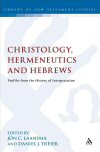
Christology, Hermeneutics, and Hebrews: Profiles from the History of Interpretation
- Editors: Jon C. Laansma and Daniel J. Treier
- Series: The Library of New Testament Studies (JSNTS)
- Publisher: T&T Clark
- Publication Date: 2012
- Pages: 288
Christology and Hermeneutics discusses the history of the interpretation of the Letter to the Hebrews. Contributors assess the study and interpretation of Hebrews across the last two millennia. Beginning with the Patristic period, the book examines the responses of Thomas Aquinas, Martin Luther, John Calvin, as well as more recent figures such as Karl Barth and contemporary global interpreters.
The premise behind the work is to move the study of Hebrews away from the perennial arguments about its authorship and provenance and to instead engage with it from a theological perspective, focusing upon the text’s reception history. Consequently the issue of the Christological message in Hebrews is at the forefront and is considered both in terms of the interpreter’s context and historical setting. At the end of the book the investigations are summarized and responded to by leading scholars Harold Attridge, Donald A. Hagner and, Kathryn Greene-McCreight; providing a fitting conclusion to this notable academic project.
This book is worth buying for professor Laansma’s introduction alone. The other essays in the volume make this a necessary book for anyone who seeks to understand Hebrews—today and in the history of Christian exegesis—and indeed for anyone who seeks to grapple with the question of how Christians today should read Scripture. The book manages to be both scholarly and inspiring. Theologians who strive to read Scripture faithfully will find this book to be a powerful stimulant for reflection and growth.
—Matthew Levering, professor of theology, University of Dayton
Hebrews has played a significant and sometimes controversial role in Christian thought. This fine collection of essays explores the way that major thinkers have engaged Hebrews over the centuries. The contributors show us the vitality of theological interpretation of Hebrews and open up valuable perspectives on this intriguing text. Their work will be welcomed by students of Scripture, theology, and the history of the church.
—Craig R. Koester, Professor and Asher O. and Carrie Nasby Chair of New Testament, Luther Seminary, St. Paul, Minnessota
There are three reasons for welcoming Jon C. Laansma and Daniel J. Treier’s book: first, because it provides an impressive overview of the scientific debate on Hebrews, against the larger backdrop of New Testament Studies and the modern history of ideas. Second, because it is the first collected volume dedicated to the neglected reception history of Hebrews. And finally, because it is the first book to gather a chorus of patristic-theological voices on the interpretation of Hebrews.
—Gabriella Gelardini, Wissenschaftliche Oberassistentin am Lehrstuhl für Neues Testament, University of Basel
Jon C. Laansma is associate professor of ancient languages and New Testament at Wheaton College, Illinois. He is the author of Cornerstone Biblical Commentary: 1 & 2 Timothy, Titus, Hebrews. He also contributed the introductions and notes for 1 & 2 Timothy and Titus for the New Living Translation Study Bible Notes.
Daniel J. Treier (MDiv and ThM, Grand Rapids Theological Seminary; PhD, Trinity Evangelical Divinity School) is associate professor of theology at Wheaton College in Wheaton, Illinois. He has also taught at Trinity Evangelical Divinity School and Cornerstone University in Grand Rapids, Michigan. He is the author or editor of several books including Brazos Theological Commentary on the Bible: Proverbs & Ecclesiastes, Introducing Theological Interpretation of Scripture: Recovering a Christian Practice, Justification: What’s at Stake in the Current Debates, and Dictionary for Theological Interpretation of the Bible.
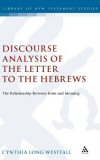
This study attempts to analyze the text of Hebrews with a method of discourse analysis primarily based on a form of systemic functional linguistics developed for Hellenistic Greek, but it is also informed by other linguistic studies. It begins with a general survey of the literature that is either influential or representative of approaches to the structure of Hebrews. The survey is followed by an introduction to the terminology and definitions of discourse analysis, as well as the theory behind the methodology and a description of the methodology itself.
Hebrews is treated as having three sections. The first section of Hebrews (1:1–4:16) demonstrates the organization of the units, the topic of the units, the prominent text, and the relationship of the first section with the rest of the discourse. The second section of Hebrews (4:11–10:25) is described in two parts (4:11–7:28 and 8:1–10:25) because of its length. There is an overlap between the first and second sections in 4:11–16 and between the second and third sections in 10:19–25. Both of these passages have a concluding function for the preceding co-text and a staging function for the following co-text, so that they look backwards and forwards. The third and final section in 10:19–13:25 contains the climax or discourse peak. The study concludes with a description of the coherence of the discourse and a presentation of a mental representation of the text.
. . . A more specialized biblical studies collection may wish to invest in what is without doubt a major study of this area and a good example of this particular methodological approach.
—Theological Book Review
Westfall is to be congratulated on a remarkable fusion of the insights of current linguistic theory with a detailed, down-to-earth reading of the Greek text of Hebrews, producing what is in effect a special type of commentary.
—Paul Ellingworth, translation consultant, the United Bible Societies
Cynthia Long Westfall (PhD, University of Surrey Roehampton, London) is assistant professor of New Testament at McMaster Divinity School. She has served as cochair of the Biblical Greek and Linguistics section of the Society of Biblical Literature, cochair of the Evangelicals and Gender section of the Evangelical Theological Society, and the steering committee of the Hebrews section of the Evangelical Society.
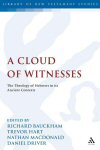
The book of Hebrews has often been the Cinderella of the New Testament—overlooked and marginalized. Yet, it is one of the most interesting and theologically significant books in the New Testament.
A Cloud of Witness examines the theology of the book in the light of its ancient historical context. There are chapters devoted to the structure of Hebrews, the person of Jesus Christ, Hebrews within the context of Second Temple Judaism and the Greco-Roman empire, and the role of Hebrews in early Christian thought.
Richard Bauckham was professor of New Testament studies at St Mary's College, University of St Andrews. He recently retired from this position in order to concentrate on research and writing. He is currently the senior scholar at Ridley Hall in Cambridge and visiting professor at St. Mellitus College. Bauckham studied at the University of Cambridge and was a fellow of St. John's College. He taught theology for one year at the University of Leeds and for 15 years at the University of Manchester before teaching at the University of St. Andrews. He is a fellow of the British Academy and a fellow of the Royal Society of Edinburgh. Bauckham is known for his commentary on Jude and 2 Peter in the World Biblical Commentary and his book Jude and the Relatives of Jesus in the Early Church.
Daniel Driver is a postgraduate student at St. Andrews University, Scotland.
Trevor Hart is professor of divinity at St. Andrews University, Scotland. He is the author of several books including The Dictionary of Historical Theology and Regarding Karl Barth.
Nathan MacDonald is reader in Old Testament Studies at St. Andrews University, Scotland.
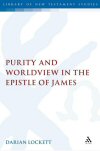
Arguing against restricting the meaning of purity language to the individual moral sphere (as many commentaries do), the central argument of Purity and Worldview in the Epistle of James is that purity language both articulates and constructs the worldview in James’s epistle. Lockett offers a taxonomy of purity language, applied as a heuristic guide to understand the function of purity and pollution in the epistle. Through this analysis the study concludes that James is not calling for sectarian separation, but rather demonstrates a degree of cultural accommodation while calling forth specific sociocultural boundaries between the readers and the world.
Lockett expertly advances his own case for the significance of purity in James and finely tunes its role as a major concern of its perfection theme . . . It covers an aspect of James that deserves treatment and provides meaningful research for others to ponder, both in its broad strokes and in its fine points. For those interested in the Epistle of James, it should be required reading.
—William R. Baker, professor of New Testament, Cincinnati Bible Seminary
. . . Lockett makes a convincing case for his thesis. It should profit serious students of James.
—Religious Studies Review
Whether it involves questions about the authorship of the letter of James, its peculiar theological assumptions, or the social setting of its readers, recent decades have seen a surge of interest, even fascination, with the document. Based on his research at the University of St. Andrews under the guidance of Ron Piper, Darian Lockett has contributed a valuable monograph to the literature. Current and future students will need to stir his conclusions into the mix of the ongoing research.
Darian Lockett is assistant professor of New Testament at the Talbot School of Theology at Biola University.
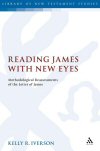
The letters of James, 1 and 2 Peter, and Jude are among the most neglected letters of the New Testament. Thus, methodological advances in New Testament study tend to arise among the Gospels or Pauline letters. But now these letters are beginning to receive increased attention in the scholarly community.
Reading James with New Eyes is the first of four volumes that incorporate new research in this area. The essays collected here examine the impact of recent methodological developments in New Testament studies to the letter of James. The developments analyzed include, for example, rhetorical, social-scientific, socio-rhetorical, ideological, and hermeneutical methods. Each essay has a similar three-fold structure, making them perfect for use by students: 1) a description of the methodological approach; 2) the application of the methodological approach to James; and 3) a conclusion identifying how the methodological approach contributes to a fresh understanding of the letter.
Robert L. Webb lectures in the Religious Studies Department of McMaster University, Hamilton, ON, Canada. His is the coeditor of the Nag Hammadi Texts and the Bible: A Synopsis and Index. He is the executive editor of the Journal for the Study of the Historical Jesus (Sage) and of the monograph series Library of Historical Jesus Studies (a subset of the Library of New Testament Studies).
John S. Kloppenborg is professor and chair of the Department for the Study of Religion at the University of Toronto. He is the coauthor of Apocalypticism, Anti-Semitism, and the Historical Jesus: Subtexts in Criticism.
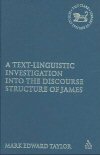
This study uncovers significant structuring techniques in James that prove to be beneficial in a number of ways. First, there exists a coherent, discernible strategy in the letter as a whole. Second, significant uses of inclusio, along with other transition techniques, draw attention to important recurring themes. Third, the quotation of Leviticus 19:18 and echoes of the Shema (Deuteronomy 6) occur in significant structural locations suggesting that the double-love command in the Jesus tradition (cf. Matthew 22:34–40) is a hermeneutical key to the interpretation of the letter. The study begins with an introduction to the research problem and its significance for interpretation. Chapter one summarizes and critiques past proposals of the structure of James. Chapter two explains the text-linguistic methodology employed in the study that is then applied in chapters three, four, and five. Chapter six offers a proposed structure for the letter that consists of a double introduction (1:2–11 and 1:13–27) joined by an overlapping transition (1:12), a carefully crafted letter body (2:1–5:6) that is bracketed by a major inclusio (2:12–13 and 4:11–12), and a conclusion (5:7–20).
Mark E. Taylor is assistant professor of New Testament and associate dean for the master’s degree programs at Southwestern Baptist Theological Seminary in Fort Worth, Texas.
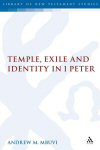
Temple, Exile, and Identity in 1 Peter
- Author: Andrew Mutua Mbuvi
- Series: The Library of New Testament Studies (JSNTS)
- Publisher: T&T Clark
- Publication Date: 2007
- Pages: 192
Temple, Exile, and Identity in 1 Peter will generate a fresh understanding of the main themes of 1 Peter, which include questions of identity, suffering, hope, holiness, and judgment. Mbuvi explores the temple imagery in the epistle of 1 Peter and focuses on the use of cultic language in constituting the new identity of the Petrine community. He contends that temple imagery in 1 Peter undergirds the entire epistle.
First Peter directly connects the community’s identity with the temple by describing it in terms reminiscent of the temple structure. He calls the members of the community “living stones,” formulating an image that has been categorized as a “Temple-Community.” This concern with the temple characterizes the restoration eschatology in the Second Temple period with its focus on the establishment of the eschatological temple. Restoration of Israel was also to be characterized by hope for the regathering of the scattered of Israel, the conversion or destruction of the Gentiles, and the establishment of God’s universal reign, all of which are reflected in the discourse of the epistle.
Andrew Mutua Mbuvi is assistant professor at Shaw University Divinity School. He holds a PhD in hermeneutics and biblical interpretation from Westminster Theological Seminary and completed postdoctoral research at Duke University.
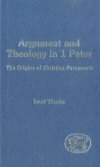
Using both ancient and modern rhetoric, linguistics, and argumentation theory, this study offers a fresh approach to 1 Peter and New Testament ethics. It is often claimed that the growing interest in paraenesis, or ethical teaching, among early Christians indicates how Jesus’ revolutionary teaching and the Pauline notion of justification by faith were gradually replaced by an emphasis on good works and ethics borrowed from the surrounding Hellenistic and Jewish culture. The motivation of the paraenesis challenges this traditional view of ethics in early Christianity, arguing that paraenesis was an original, essential part of early Christian doctrine and life. The book also provides a new, well-balanced picture of 1 Peter and its message, giving a natural interpretation to many puzzling sections and clarifying the internal logic of the text and the theology behind it.
Lauri Thurén is senior research fellow at the Academy of Finland.
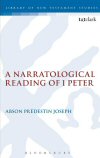
A Narratological Reading of 1 Peter
- Author: Abson Prédestin Joseph
- Series: The Library of New Testament Studies (JSNTS)
- Publisher: T&T Clark
- Publication Date: 2013
- Pages: 224
Employing a narratological approach, Abson Joseph links the structure of 1 Peter with God’s actions on behalf of Israel. Using a three-layered distinction of narrative—fabula (raw material), story, and text—Joseph studies the text of 1 Peter and shows the presence of a fabula that comprises four main elements: election, suffering, steadfastness, and vindication. Joseph asserts that this fabula is common to the experiences of Israel, Jesus, and the epistle’s audience and thus shapes the narrative substructure of the epistle and constitutes the lens through which the author urges his audience to make sense of its situation.
Joseph argues that the author of 1 Peter urges the audience to view suffering only as a temporary experience that befalls the elect. Suffering is to be met with faithful response because God vindicates the righteous sufferer. The narrative substructure provides evidence of God’s vindication of righteous sufferers, serves as basis for the author’s exhortations to the audience, and substantiates his claims about God’s ability to vindicate those who remain steadfast in the face of suffering.
Abson Prédestin Joseph is associate professor of New Testament at Indiana Wesleyan University.
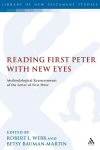
The letters of James, 1 and 2 Peter, and Jude are among the most neglected letters of the NT. Thus, methodological advances in NT study tend to arise among the Gospels or Pauline letters. But these letters are beginning to receive increased attention in the scholarly community.
Reading First Peter with New Eyes is the second of four volumes that examine the impact of recent methodological advances in New Testament studies of the letters of James, 1 and 2 Peter and Jude. This volume includes analysis of rhetorical, social-scientific, socio-rhetorical, ideological, and hermeneutical methods, as they contribute to understanding First Peter and its social context. Each essay has a similar three-fold structure, ideal for use by students: 1) a description of the methodological approach; 2) the application of the methodological approach to First Peter; and 3) a conclusion identifying how the methodological approach contributes to a fresh understanding of the letter.
The value of this collection lies in the way each contributor clearly delineates a particular methodological approach and creatively demonstrates how it can be applied to 1 Peter. No contributor assumes a one-size-fits-all approach to his or her respective methodologies, but rather each acknowledges how models and theories need to be re-appropriated in light of the unique characteristics and context of 1 Peter. As a whole, this volume helps to bring 1 Peter further out of the shadow of Pauline scholarship, exemplifies new developments in Petrine scholarship, and casts light on some possibilities for further application of these methodologies.
—Biblical Interpretation
Robert L. Webb lectures in the Religious Studies Department of McMaster University, Hamilton, ON, Canada. His is the coeditor of the Nag Hammadi Texts and the Bible: A Synopsis and Index. He is the executive editor of the Journal for the Study of the Historical Jesus (Sage) and of the monograph series Library of Historical Jesus Studies (a subset of the Library of New Testament Studies).
Betsy Bauman-Martin is assistant professor of religious studies at St. Norbert College.
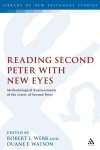
The letters of James, 1 and 2 Peter, and Jude are among the most neglected letters of the NT. Thus, methodological advances in NT study tend to arise among the Gospels or Pauline letters. But these letters are beginning to receive increased attention in the scholarly community.
Reading Second Peter with New Eyes is the third of four volumes that incorporate research in this area. This volume includes analysis of rhetorical, social-scientific, socio-rhetorical, ideological, and hermeneutical methods, as they contribute to understanding First Peter and its social context. Each essay has a similar three-fold structure, ideal for use by students: 1) a description of the methodological approach; 2) the application of the methodological approach to First Peter; and 3) a conclusion identifying how the methodological approach contributes to a fresh understanding of the letter.
. . . The collection of essays provides an accessible entry point that contains informative methodological summaries for those interested in 2 Peter studies.
—Journal for the Study of the New Testament
Robert L. Webb lectures in the Religious Studies Department of McMaster University, Hamilton, ON, Canada. His is the coeditor of the Nag Hammadi Texts and the Bible: A Synopsis and Index. He is the executive editor of the Journal for the Study of the Historical Jesus (Sage) and of the monograph series Library of Historical Jesus Studies (a subset of the Library of New Testament Studies).
Duane F. Watson is professor of New Testament studies at Malone College in Canton, Ohio.
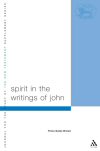
Employing the methodology of social-scientific biblical criticism, the author investigates the pneumatology of John and 1 John. With particular attention paid to the spirit passages in John, the pneumatology of 1 John is studied with a view to the development between the two writings and to what this suggests about the socio-cultural context of the Johannine community. This study explores patron-client relations, and specifically the variation known as brokerage, and its explanatory power in elucidating the relationship between God, Jesus, the Spirit-Paraclete, and believers.
The author asserts that the Spirit in John is characterized as a broker and that this understanding figures prominently in the theology of the fourth Gospel as well as in the debate reflected in 1 John.
Brown’s study is the first major attempt to apply patron-client categories to Johannine pneumatology . . . this remarkable, ground-breaking study is a must for scholars of John’s pneumatology.
—The Catholic Biblical Quarterly
Tricia Gates Brown received her PhD from the University of St. Andrews and is an independent scholar living and working in Newberg, Oregon.
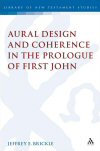
Aural Design and Coherence in the Prologue of First John
- Author: Jeffrey E. Brickle
- Series: The Library of New Testament Studies (JSNTS)
- Publisher: T&T Clark
- Publication Date: 2012
- Pages: 176
Unlike literature of the modern western world, ancient documents were typically crafted for the ear rather than the eye. This new investigation of the structure of 1 John’s prologue analyzes the oral patterning and resulting soundscape reflected in this key New Testament passage.
After discussing contemporary techniques of sound analysis and establishing the study’s methodological approach, Brickle examines the prologue’s aural profile. He explores, describes, and depicts graphically the patterns of sound that emerge as the text is read aloud. Brickle uses the approaches to Greek pronunciation and aurality advocated in the recent New Testament research to determine the impact on the prologue’s soundscape, followed by an analysis employing the principles for beautiful and effective composition elucidated by the ancient teacher of rhetoric, Dionysius of Halicarnassus, in his treatise, On Literary Composition. A final section draws together the results and implications of the study before suggesting further ways to apply research in aurality, performance, and memory to the prologue and other ancient texts.
Jeffrey E. Brickle is associate professor of biblical studies at Urshan Graduate School of Theology in Florissant, Missouri.
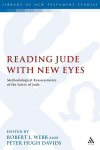
The letters of James, 1 and 2 Peter, and Jude are among the most neglected letters of the New Testament. Thus, methodological advances in New Testament study tend to arise among the Gospels or Pauline letters. But these letters are beginning to receive increased attention in the scholarly community.
Reading Jude with New Eyes is the fourth of four volumes that incorporate research in this area. The essays collected here examine the impact of recent methodological developments in New Testament studies to Jude, including, for example, rhetorical, social-scientific, socio-rhetorical, ideological, and hermeneutical methods, as they contribute to understanding this letter and its social context. Each essay will have a similar three-fold structure: 1) a description of the methodological approach; 2) the application of the methodological approach to the particular letter under consideration (the bulk of the essay); and 3) a conclusion identifying how the methodological approach contributes to a fresh understanding the letter.
Robert L. Webb lectures in the Religious Studies Department of McMaster University, Hamilton, ON, Canada. His is the coeditor of the Nag Hammadi Texts and the Bible: A Synopsis and Index. He is the executive editor of the Journal for the Study of the Historical Jesus (Sage) and of the monograph series Library of Historical Jesus Studies (a subset of the Library of New Testament Studies).
Peter Hugh Davids is professor of New Testament theology at St. Stephen’s University, New Brunswick, Canada. He is the author of The Epistle of James in the New International Greek Testament Commentary series and The Letters of 2 Peter and Jude in the Pillar New Testament Commentary series.
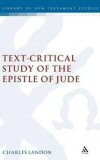
The author writes in the tradition of C. H. Turner, G. D. Kilpatrick, and J. K. Elliott, and attempts a reconstruction of the Greek text of Jude according to the rationale of thoroughgoing eclecticism. The aims of his study are to apply an eclectic approach to the resolution of textual problems in Jude and to determine the extent to which the text of Jude published in the UBS Greek New Testament is a product of the eclectic ideal. In this work, eclecticism is defined in detail, distinctions being made between eclectic generalism, rational criticism, and thoroughgoing eclecticism. Each of 95 variation units is analyzed individually and the apparatus provided for each unit shows as much variation as possible in a compact form.
Charles Landon is an independent researcher living and working in Ulm, Germany.
Reviews
1 rating
J.R. Woods
11/25/2013
I would pay this much JUST for Westfall's resource on Hebrews alone and there are many that do so on Amazon! I cannot wait for this to come out. I really hope and pray that more of these text-linguistic studies on the Gospels and NT Greek (at least the modern ones) will come out very soon!!